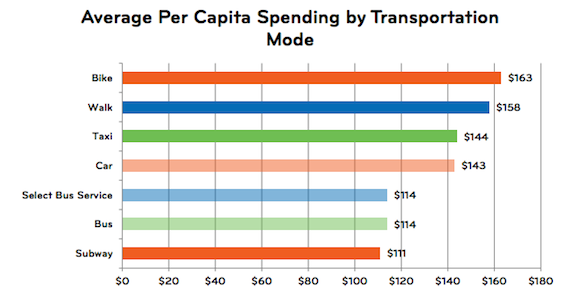
On the heels of launching New York's first "Bike Friendly Business District" in the East Village and Lower East Side, Transportation Alternatives has released a new study [PDF] showing that people who walk, bike and take transit to the East Village are local retailers' best customers.
In a random survey of 420 East Village pedestrians, 95 percent of respondents said that they usually walk, bike or take transit to the neighborhood, with only 5 percent using a taxi or private automobile. TA asked respondents how often they visit the area and how much they usually spend per visit, using the replies to calculate how much each person typically spends per week in the area. The interesting patterns emerge when you segment that information by how the respondents got to the neighborhood. It shows that bicyclists and pedestrians are bigger spenders than those who arrive by taxi and car.
That's because the people who come to the area most often typically arrive by bike or on foot. Nearly two-thirds of pedestrians and bicyclists – but only 44 percent of drivers – visited the area five or more times per week. Although the subway is the most popular way to get to the East Village, only a third of subway riders visited the area five or more times each week, reducing each rider's spending impact at retailers.
TA staff and volunteers conducted the surveys during the morning, afternoon and evening on weekdays and weekends in July. Nearly three-quarters of respondents were Manhattan residents, with more than half coming from East Village zip codes. “Respondents skewed younger and male,” said TA, with 53 percent under age 35.

The study also found that 67 percent of women, and 56 percent of men, said that protected bike lanes on First and Second Avenues have made them more likely to bike in the neighborhood. However, when asked to name the biggest barrier to riding a bike in the neighborhood, 42 percent cited a lack of enforcement against dangerous driving.
TA's study replicates a report by NYU undergraduate students in 2010, before the bike and bus lanes were installed. TA's 2012 study shows only 5 percent of shoppers arriving by car or taxi; in 2010, the number was 12 percent.
The Bike Friendly Business District draws inspiration from Long Beach, California, which already has six participating districts. In addition to discounts for customers arriving by bike, shared cargo bikes are available for businesses to make deliveries of large goods.
The East Village studies join a growing body of literature showing that although customers who drive spend more per visit, people who shop by foot, bike or transit visit more often and end up spending more money in stores.
Studies in Toronto show that fewer customers drive to shop than retailers think, while in Portland, businesses themselves have cited the benefits of on-street bike parking.
In 2006, Bruce Schaller, now a deputy commissioner at NYC DOT, conducted a study for Transportation Alternatives finding that shoppers on crowded Prince Street in Soho said they'd be more likely to visit if the street had more pedestrian space. Only nine percent of people on Prince Street arrived by car.





